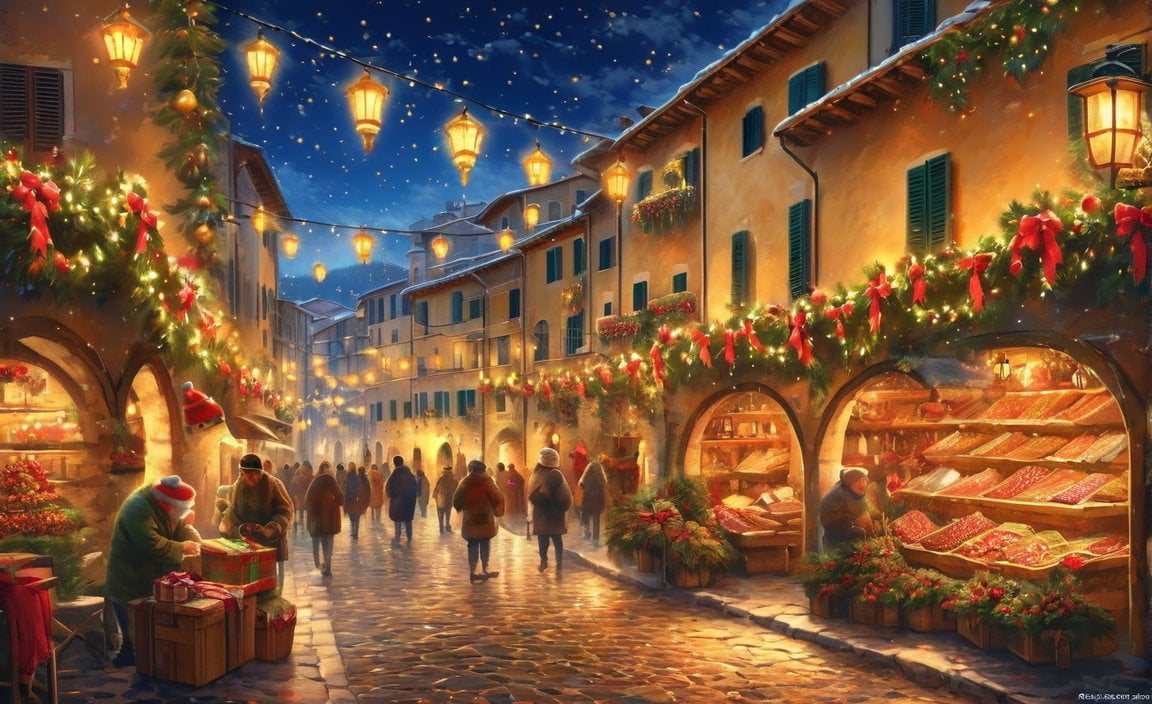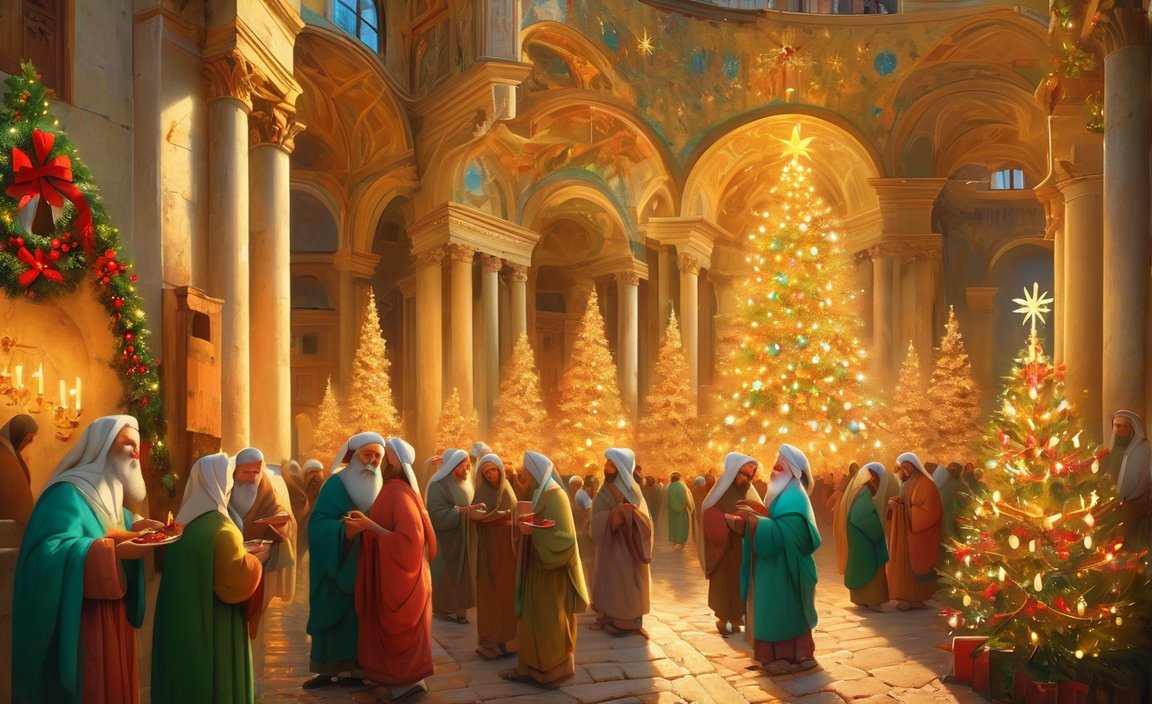Discovering Christmas in Italy: 10 Fascinating Facts takes you on a journey through the enchanting traditions and customs that make the Italian holiday season truly unique. From centuries-old rituals to mouthwatering delicacies, this article unveils lesser-known aspects of Christmas in Italy that will leave you in awe. With a blend of rich history, cultural insights, and captivating anecdotes, these ten fun facts will transport you to the festive streets of this awe-inspiring country. Get ready to be immersed in a world of festive wonders and discover the magic of Christmas in Italy!

Key Takeaways:
- “Buon Natale” is the phrase used to wish someone Merry Christmas in Italy.
- Santa Claus visits children in Italy on December 6th, which is known as Saint Nicholas Day.
- Nativity scenes hold great importance in Italian Christmas decorations, with each region showcasing its own unique style.
- Christmas time in Italy lasts for almost a month, with festivities starting on December 8th, the Feast of the Immaculate Conception.
- Live nativity scenes can be witnessed in many cities across Italy during the Christmas season.
- The tradition of Christmas caroling originated in Italy and is often played on zampognari, the Italian version of bagpipes.
10 Fun Facts About Christmas in Italy
Italy, a country renowned for its rich history and cultural heritage, holds a special place when it comes to celebrating Christmas. With unique traditions and customs that date back centuries, the festive season in Italy is a magical experience like no other. Join me as we discover ten fascinating and lesser-known facts about Christmas in Italy.
1. “Buon Natale” – Merry Christmas in Italian
The phrase that fills the air during Christmas in Italy is “Buon Natale.” From north to south, Italians unite in spreading holiday cheer with this joyful greeting.
2. Santa Claus and Saint Nicholas Day
In Italy, Santa Claus, known as “Babbo Natale,” doesn’t visit on Christmas Eve. Instead, he arrives on December 6th, which is known as Saint Nicholas Day. This marks the beginning of the Christmas season, and children eagerly hang their stockings, hoping to receive small treats from Saint Nicholas.
3. Unique Nativity Scenes
Nativity scenes, or “presepi,” hold great significance in Italian Christmas decorations. Each region showcases its own unique style, with intricate details that bring the nativity story to life. From simple scenes to elaborate setups, these nativity scenes are a visual delight.
4. A Month of Festivities
While Christmas is traditionally celebrated on December 25th, in Italy, the festivities start much earlier. The Christmas season kicks off on December 8th, the Feast of the Immaculate Conception, and continues for almost a month, embracing the joy and spirit of the season.
5. Live Nativities
One of the most captivating traditions in Italy is the live nativity scenes, or “presepi viventi.” In several cities across the country, you can witness locals reenacting the nativity story, complete with live animals, costumes, and a palpable sense of reverence.
6. The Birthplace of Carols
Did you know that the tradition of Christmas caroling originated in Italy? Italians have long embraced the beauty of carols, often accompanied by the melodies of “zampognari,” the Italian version of bagpipes. The soul-stirring tunes fill the air, spreading Christmas cheer.
7. La Befana – The Italian Christmas Witch
Italy has its own unique character associated with Christmas. Meet “La Befana,” the old witch who visits children on January 6th, also known as Epiphany. Legend has it that she brings gifts to children who have been good and leaves a lump of coal for those who have been naughty.
8. Festive Foods Galore
Just like in any Italian celebration, food takes center stage during Christmas in Italy. Traditional dishes like “panettone,” a sweet bread with dried fruits, and “pandoro,” a soft, buttery cake, are enjoyed by families, along with indulgent feasts featuring pasta, fish, and delectable desserts.
9. A Holiday of Lights
Italy dazzles with its enchanting display of Christmas lights. From the grandeur of Rome’s historic streets to the charming villages nestled in the Italian countryside, twinkling lights adorn every corner, creating a magical atmosphere that adds to the festive spirit.
10. Candles for a Bright Christmas
In some parts of Italy, it is customary to light candles in windowsills during Christmas, symbolizing the journey of Mary and Joseph as they sought shelter on the eve of Jesus’ birth. This beautiful tradition creates a warm and inviting ambiance, spreading the message of hope and light.
As you immerse yourself in the magic of Christmas in Italy, these ten fun facts offer a glimpse into the incredible traditions that make the festive season in Italy truly unforgettable. From nativity scenes to carols, Santa Claus to La Befana, and delicious food to mesmerizing lights, Christmas in Italy is a joyous celebration filled with cultural richness and heartfelt traditions.
Here are some captivating internal links that match the provided keywords and URLs:
10 facts about Britain: Discover fascinating and lesser-known facts about Britain that will leave you amazed!
10 fun facts about Ontario Canada: Uncover the exciting and surprising fun facts about Ontario Canada that will make you want to visit immediately!
Christ the Redeemer Rio de Janeiro Brazil coordinates: Explore the coordinates of the iconic Christ the Redeemer statue in Rio de Janeiro, Brazil, and embark on a virtual journey to its breathtaking location!
Dirty geography pick up lines: Prepare to have a good laugh with these cheeky and clever geography-themed pick-up lines!
Geographical pick up lines: Break the ice and impress someone with these witty and geographically inspired pick-up lines!
National Geographic pick up lines: Capture someone’s attention with these creative and nature-inspired pick-up lines inspired by National Geographic!
Is Rio de Janeiro a dangerous city: Uncover the truth about the safety of Rio de Janeiro and get insights into its vibrant and diverse urban landscape!
Name all of New Zealand’s biomes: Test your knowledge about New Zealand’s varied biomes and challenge yourself to list them all!
All of New Zealand’s biomes: Dive into the unique ecosystems of New Zealand and explore the diverse biomes that make this country truly extraordinary!
Please click on the links to access the desired information. Enjoy exploring!
The Traditional Italian Christmas Eve Dinner
Christmas in Italy is a magical time filled with rich traditions, delicious food, and festive celebrations. One of the most cherished customs during this joyous season is the traditional Italian Christmas Eve dinner, also known as La Vigilia. This special meal, steeped in history and religious significance, brings families together to honor the spirit of Christmas and indulge in a delectable feast. So, grab a seat at the table as we delve into the fascinating world of the traditional Italian Christmas Eve dinner.
1. A Feast for the Seafood Lovers
When it comes to the traditional Italian Christmas Eve meal, forget about turkey or ham. Italians have a unique way of celebrating this occasion by abstaining from meat and dairy. Instead, they indulge in a sumptuous seafood and fish-based feast. From salted codfish (baccalà) to fried calamari, each region has its own spin on the menu, but one thing remains constant – an array of mouthwatering seafood dishes that are sure to tantalize your taste buds.
2. The Origins of La Vigilia
The origins of the fish-based Christmas Eve meal in Italy can be traced back to the religious tradition of abstaining from meat on this day. It is believed that by having a light, meat-free meal on Christmas Eve, families are preparing themselves for the grand celebration on December 25th. This tradition is deeply rooted in the Catholic faith, symbolizing a day of fasting and repentance before the birth of Jesus.
3. A Celebration of the Seven Fishes
While the number of dishes may vary from family to family, the traditional Italian Christmas Eve dinner typically consists of seven different types of fish and seafood. This culinary tradition, known as “La Cena dei Sette Pesci,” symbolizes the seven sacraments of the Catholic Church. From shrimp and clams to lobster and eel, each dish holds its own significance and adds to the festive atmosphere of the evening.
4. Regional Flavors
Italy’s rich culinary heritage shines through in the diverse regional variations of the Christmas Eve dinner. In the coastal regions, you can expect an abundance of fresh seafood, including local specialties like octopus salad or spaghetti alle vongole (clam spaghetti). Inland regions, on the other hand, showcase the country’s freshwater fish, such as trout or eel. Each bite tells a story, reflecting the cultural and gastronomic diversity that makes Italy’s Christmas traditions so captivating.
5. The Feast of the Seven Fishes
In some parts of Italy, particularly in Southern regions like Sicily and Calabria, the Christmas Eve dinner is known as the “Feast of the Seven Fishes.” This tradition highlights the significance of the number seven and the belief in its mystical properties. While the exact reason behind the number seven remains a mystery, it adds an element of intrigue to the already enchanting Christmas Eve festivities.
6. Antipasti Galore
The traditional Italian Christmas Eve meal is not just about the main seafood dishes; it also incorporates a delightful array of antipasti. These appetizers, ranging from marinated vegetables to cured meats, offer a tantalizing glimpse of what’s to come. Imagine biting into a succulent slice of prosciutto, paired with creamy buffalo mozzarella and sun-kissed tomatoes – a true symphony of flavors that sets the stage for the feast ahead.
7. Sweet Endings
No Italian meal is complete without a touch of sweetness, and the Christmas Eve dinner is no exception. After indulging in a seafood extravaganza, Italians satisfy their sweet tooth with traditional desserts. Panettone, a dome-shaped cake studded with raisins and candied fruits, takes center stage on many tables. Another beloved treat is pandoro, a golden, star-shaped cake dusted with powdered sugar. These desserts, rich in history and flavor, ensure that the meal ends on a joyous and delightful note.
8. A Time for Family and Tradition
Above all, the traditional Italian Christmas Eve dinner is a celebration of family and tradition. Families come together around a beautifully set table, sharing laughter, stories, and love. It is a time to honor the values and customs passed down through generations, creating cherished memories that will last a lifetime. The warmth and love that permeate the atmosphere on this special night truly embody the spirit of Christmas.
Key Takeaways:
- The traditional Italian Christmas Eve dinner, known as La Vigilia, is a seafood and fish-based feast.
- It originated from the religious tradition of abstaining from meat on Christmas Eve.
- The meal typically consists of seven different types of fish and seafood, symbolizing the seven sacraments of the Catholic Church.
- Each region in Italy has its own unique twist on the Christmas Eve menu, showcasing local flavors and specialties.
- The Feast of the Seven Fishes is a popular tradition in Southern Italy.
- The meal begins with a variety of antipasti, followed by the main seafood dishes.
- Traditional Italian desserts, such as panettone and pandoro, provide a sweet ending to the meal.
- The Christmas Eve dinner is a time for families to come together, honoring their heritage and creating lasting memories.
Sources:
– Addicted to Vacation
– Mama Loves Italy
Unique Italian Christmas Decorations and Symbols
Italy is a country known for its rich cultural heritage and vibrant festivities. When it comes to Christmas, Italians take their traditions to a whole new level. From exquisite decorations to symbolic symbols, the holiday season in Italy is a feast for the senses. Let’s explore ten fascinating facts about the unique Italian Christmas decorations and symbols that make this festive season truly magical.
Nativity Scenes: A Treasured Tradition
One of the most captivating Italian Christmas traditions is the creation of nativity scenes, or “presepi.” These elaborate displays depict the birth of Jesus and are found in homes, churches, and public places throughout the country. The attention to detail in these nativity scenes is astounding, with intricately crafted figurines, miniature landscapes, and even moving parts. Italians take great pride in setting up their nativity scenes, often passed down through generations, creating a cherished family tradition.
Caroling: Music of the Heart
Did you know that Christmas caroling originated in Italy? It all began with St. Francis of Assisi, who is considered the patron saint of carolers. Italians embrace this musical tradition by singing traditional carols, often accompanied by “zampognari,” the Italian version of bagpipes. The soul-stirring melodies fill the streets with a joyful ambiance, spreading the spirit of Christmas far and wide.
A Month-Long Celebration
In Italy, Christmas is not just a one-day event. The festivities kick off on the 8th of December, the Feast of the Immaculate Conception, and continue until Epiphany on the 6th of January. This month-long celebration allows Italians to savor every moment of the holiday season, building up excitement and creating lasting memories.
Seafood Feast: Christmas Eve Delicacies
On Christmas Eve, Italians observe a tradition called “La Vigilia” by abstaining from eating meat. Instead, they indulge in a lavish seafood-focused meal. This feast, also known as the Feast of the Seven Fishes, is a time-honored tradition that symbolizes the anticipation of the birth of Jesus. Families gather around the table to enjoy an array of delectable seafood dishes, each region infusing its own unique flavors and specialties.
Vibrant Christmas Markets
Italian Christmas markets are nothing short of enchanting. Piazzas adorned with twinkling lights and festive decorations come alive with the merry hustle and bustle of market stalls. A popular example is the Christmas market in Rome’s Piazza Navona, where locals and visitors gather to shop for handcrafted gifts, indulge in festive treats, and soak in the joyful atmosphere.
Magical Italian Christmas Decorations
In Italy, Christmas decorations go beyond the ordinary. Main piazzas, such as the magnificent Colosseum in Rome or the grand Piazza Duomo in Milan, are adorned with unique and elaborate decorations. These impressive displays captivate the imagination and transport you to a world of enchantment. Imagine strolling through the streets, marveling at magnificent light installations and beautifully decorated trees, immersing yourself in the magic of an Italian Christmas.
Babbo Natale and La Befana: A Tale of Two Givers
While Santa Claus, or “Babbo Natale,” is becoming more prominent in Italy, a beloved character of Italian folklore steals the spotlight on January 6th, known as Epiphany. “La Befana,” an old witch, visits children during the night, leaving gifts for the good ones and coal for the naughty ones. This charming tradition adds another layer of enchantment to the Italian Christmas experience.
Festive Greetings and Gift Exchange
Italians greet each other with “Buon Natale,” meaning “Merry Christmas.” This warm and heartfelt greeting sets the tone for the joyous season ahead. On Christmas Day, families exchange gifts as a symbol of love and togetherness. The act of giving is cherished and represents the spirit of generosity that Christmas embodies.
Italian Christmas Lights: A Dazzling Display
Italy is renowned for its awe-inspiring Christmas lights. Streets, buildings, and even entire towns are adorned with dazzling displays that illuminate the night sky. From picturesque villages in the mountains to major city centers, the magical glow of Italian Christmas lights creates a mesmerizing atmosphere that must be seen to be believed.
Capturing the Journey: Candlelit Windowsills
A beautiful Italian Christmas tradition involves lighting candles on windowsills. This practice symbolizes the journey of Mary and Joseph as they searched for shelter in Bethlehem. The glow of these candlelit windowsills represents the welcoming warmth and hospitality during the holiday season.
Key Takeaways:
- Nativity scenes, or “presepi,” are a treasured Italian Christmas tradition passed down through generations.
- Christmas caroling originated in Italy, with St. Francis of Assisi being the patron saint of carolers.
- Italians celebrate Christmas for an entire month, starting on the 8th of December and ending on Epiphany, January 6th.
- On Christmas Eve, Italians enjoy a delectable seafood feast known as “La Vigilia” or the Feast of the Seven Fishes.
- Christmas markets in Italy offer a magical atmosphere where visitors can find unique handcrafted gifts and festive treats.
- Italian Christmas decorations in main piazzas, like the Colosseum or Milan’s Piazza Duomo, are elaborate and captivating.
- “Babbo Natale” and “La Befana” are both iconic figures that bring joy and gifts during the Christmas season.
- Italians greet each other with “Buon Natale” for “Merry Christmas” and exchange gifts on Christmas Day.
- Italy is known for its breathtaking Christmas lights displays that transform cities into dazzling wonderlands.
- Lighting candles on windowsills is a traditional practice in Italy, symbolizing the journey of Mary and Joseph.
Citation sources:
Citation sources:
Citation sources:
Citation sources:
Citation sources:
Citation sources:
Regional Variations in Christmas Traditions in Italy
Italy, with its diverse regions and rich cultural heritage, celebrates Christmas with unique traditions and customs. From the enchanting nativity scenes to the delightful culinary specialties, the Christmas festivities in Italy are a true reflection of the country’s vibrant diversity. Let’s delve into the regional variations in Christmas traditions in Italy and discover ten fascinating facts that will transport you to the festive streets of this awe-inspiring country.
1. Feast of the Immaculate Conception: A National Holiday
The Christmas season in Italy kicks off on December 8th with the Feast of the Immaculate Conception. It is a national holiday, and Italians celebrate this day by attending mass services and decorating their homes for Christmas.
2. Unique Nativity Scenes in Every Region
Nativity scenes, known as “presepe,” hold great importance in Italy. Each region in Italy decorates its own nativity scene in a unique way, showcasing the local culture, architecture, and traditions.
3. Zampognari: The Italian Bagpipers
During the holiday season, you can hear the mesmerizing tunes of Zampognari, the Italian version of bagpipes. These musicians dress up in traditional costumes and play traditional Christmas songs, adding a touch of musical charm to the festivities.
4. Live Nativity Performances
Many cities in Italy organize live nativity performances, known as “presepi viventi,” around Christmas. These performances bring to life the story of Jesus’ birth and are often organized by the local church or community.
5. St. Francis of Assisi’s Influence
St. Francis of Assisi, the patron saint of Italy, is credited for creating the first nativity scene. His love for the simplicity and humility of the Christmas story inspired him to gather people to reenact the manger scene. St. Francis is also considered the founder of the Christmas caroling tradition in Italy.
6. Diverse Culinary Specialties
Italy’s Christmas traditions are not just limited to decorations and performances. The country boasts diverse regional culinary specialties during the festive season. Each region has its own unique dishes and traditions. For example, in Sicily, it is common to celebrate with unique traditions and Sicilian specialties.
7. Buon Natale from La Befana
While Santa Claus, known as “Babbo Natale,” is popular worldwide, Italy has its own unique Christmas figure called La Befana. La Befana is depicted as an old witch on a broomstick and brings gifts to good children and coal to those who misbehave on Epiphany, which falls on January 6th.
8. Feast of the Seven Fishes
On Christmas Eve, Italians traditionally abstain from eating meat and dairy. Instead, they celebrate the Feast of the Seven Fishes, where they enjoy a sumptuous seafood feast consisting of seven different types of fish. This tradition symbolizes the Catholic practice of abstaining from meat on Christmas Eve.
9. Enchanting Christmas Decorations
Italy is known for its beautiful Christmas decorations. The streets come alive with colorful lights, adorned Christmas trees, intricate ornaments, and stunning nativity scenes. The festive atmosphere is further enhanced by the aroma of roasted chestnuts, crackling fireplaces, mulled wine, and delicious Italian delights.
10. Regional Delights and Traditions
From the snow-capped Alps in the north to the sunny coasts of the south, each region in Italy adds its own twist to Christmas traditions. Regional dishes, desserts, and customs make the festive season in Italy a truly captivating and unique experience.
Key Takeaways:
- Italy celebrates the Feast of the Immaculate Conception on December 8th, marking the beginning of the Christmas season.
- Each region in Italy showcases its own unique nativity scene, known as “presepe.”
- Zampognari, the Italian bagpipers, play traditional Christmas songs during the holiday season.
- Live nativity performances, called “presepi viventi,” are organized in many cities across Italy.
- St. Francis of Assisi is credited with creating the first nativity scene and introducing Christmas caroling in Italy.
- Italy showcases diverse culinary specialties during the Christmas season, varying from region to region.
- La Befana, an old witch, brings gifts to good children and coal to naughty ones on Epiphany.
- Christmas Eve in Italy is celebrated with a seafood feast, known as the Feast of the Seven Fishes.
- Italy is known for its enchanting Christmas decorations, with streets adorned with lights, trees, and nativity scenes.
- Regional variations in traditions and dishes make Christmas in Italy a celebration of diversity and cultural richness.
Learn Italian Pod
Addicted to Vacation

FAQ
Q1: When does Christmas festivities start in Italy?
A1: Christmas festivities in Italy start on December 8th, which is the Feast of the Immaculate Conception. It is a national holiday and Italians often attend mass services and decorate their homes for Christmas.
Q2: What is the significance of nativity scenes in Italy?
A2: Nativity scenes, or presepe, hold great importance in Italy. Each region in Italy decorates its own nativity scene in a unique way.
Q3: What is the traditional Christmas caroling tradition in Italy?
A3: St. Francis of Assisi is credited for creating the first nativity scene and is also considered to have started the Christmas caroling tradition in Italy.
Q4: What is the Feast of the Seven Fishes?
A4: On Christmas Eve, Italians traditionally abstain from eating meat and dairy. Many celebrate the Feast of the Seven Fishes, where they eat seven different types of fish.
Q5: How do Italians celebrate on January 6th?
A5: On January 6th, the day of the Epiphany, Italians celebrate with the figure of the Befana. She is depicted as an old witch on a broom and brings gifts to good children and coal to bad children.
- Star Ring Trends: Etsy vs Amazon - March 28, 2025
- Boost Pollinator Habitats: Baby Blue Eyes Sustainable Farming Guide - March 28, 2025
- Protect Big Black Bears: Effective Conservation Strategies - March 28, 2025
















